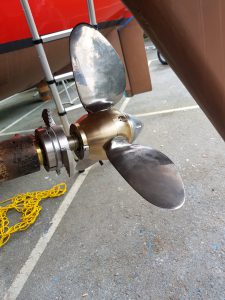If you buy an old boat, the chances are you are going to buy an old anchor.
I happen to think it’s something to get excited about – the fact that my “new” boat, Samsara, is 44 years old. At that age, a boat is ageing gracefully and improving in those important ways that people so often ignore – steadfastness, dependability…
Since I have been telling people that I have bought a Rival 32 again, I have been overwhelmed with comments such as “lovely boats” and “she’ll look after you…”
And she comes with an antique anchor: A venerable 35 lbs CQR which has served her well through all her adventures on both sides of the Atlantic.
After all, in 1973, the CQR was the anchor of choice for the cruising yachtsman – actually, there wasn’t much choice. That and a Danforth kedge seemed to see most people through most situations. But times have moved on. We now have the New Generation Anchors – and in any comparison test you care to look at, the dear old CQR comes out very poorly. The main problem is that you have to drag it around the anchorage before it will set – which may have been fine when anchorages were less crowded but try that in the Newtown River on a Saturday night and you’ll be very unpopular.
These days there are anchor manufacturers who claim their product will set in less than a metre.
Besides, the hinge on the old CQR had experienced 35 years of wear and – while there was still plenty of “drop-forged steel” to hold it together – I suspect that the geometry has gone to pot, making setting even more of a problem.
So I did my research and I’ve gone for a New Zealand-designed Rocna.
The next choice was the size. According to the company’s chart, the 15kg would be ample – that’s 33lb. The trouble was, my eye kept sliding across to the next column, the 20kg (44lb). For a 32ft boat, that would be considered a storm anchor.
It is argued that boats heading for extended cruising should carry a storm anchor. It is also argued that by the time you realise you should have set the storm anchor, it will not be a very good moment to try and do so. You will sleep a lot better if you know it’s down there already.
So it was back onto Google for more research. This was when I stumbled on advice from the Rocna people saying they discourage going up a size. They had already factored in everything the prudent yachtsman would need for peace of mind.
So I called up Pirates Cave to order the 15kg.
“There’s been a run on them,” said Nathan. “In fact, our supplier – the only supplier in the UK – won’t be getting any until September.”
That was no good. I needed to get the new bow roller measured – and the piece of stainless steel to protect the hull where the tip will rest…
“I can do the 20kg,” said the voice on the other end. “I can get that out to you today…”
In end it doesn’t look out of place on the bow – and best of all, it might have been made for its passage-making stowage in the fo’c’sle.

